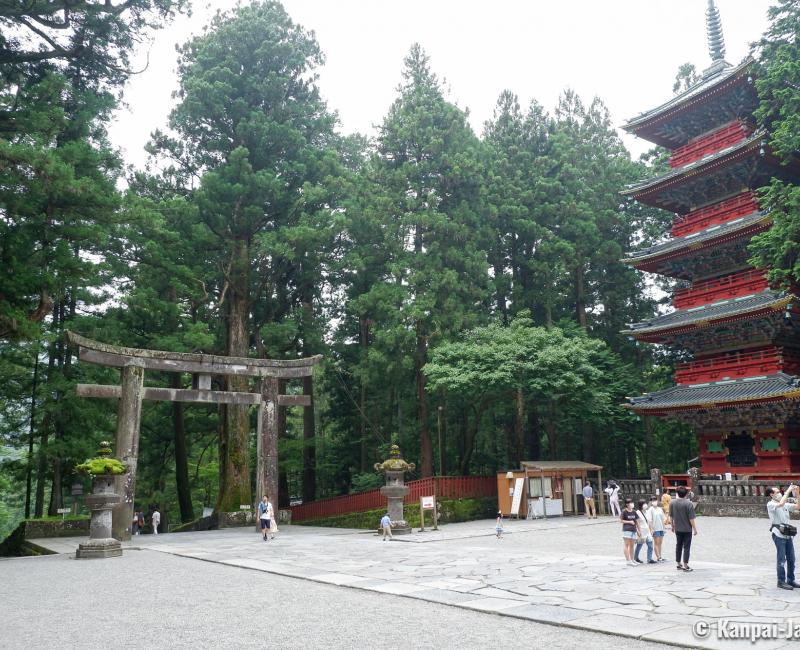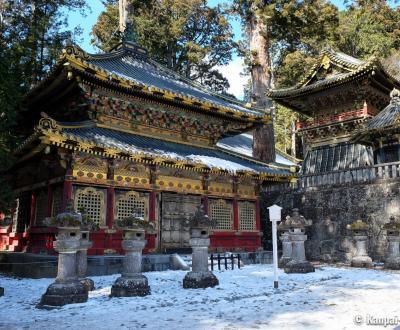Toshogu
The Pearl of Nikko
Toshogu is a large and lavish shrine located in Nikko National Park in Tochigi Prefecture in the north of Tokyo. This extensive set of richly decorated buildings is organized around the mausoleum of Tokugawa Ieyasu a prominent feudal lord. The religious complex, both Shinto and Buddhist has been undergoing renovation works since 2007.
Tokugawa Ieyasu (1543 – 1616) was one of Japan’s shogun and a key figure of Japanese history. He gave his name to the Tokugawa shogunate which ruled over Japan for more than 250 years until Meiji restoration.
A pilgrimage to honor Tokugawa Ieyasu
Even though certain documents mention 1636 as the date of construction, the complex spread gradually around the Mausoleum under the rule of Tokugawa Ieyasu’s son Hidetada in the first half of the 17th century and then under that of his grandson Iemitsu. Construction is believed to have cost 40 billion current yens (~257.4 million dollars). Several buildings of the Toshogu shrine either became Unesco World Heritage sites in 1999 or have received official recognition from the Japanese Government as National Treasures and Major Cultural Property.
Dozens of variously-sized buildings, each more richly decorated than the last, spread over these extensive premises in the heart of the forest of Nikko National Park. The unusual mix of Shinto shrines and Buddhist buildings gives the Shinto architecture a grandiose dimension. Simplicity is simply not the point, and the ornate buildings offer a wealth of colors and details, including gold leaf decorations which may surprise careful observers.
Some of the most famous and most interesting of the Toshogu buildings include:
- The entrance gate, an immense torii ⛩️ (Ishidorii) at the end of the large, straight, uphill path;
- The five-story pagoda (Gojunoto) which you see as soon as you pass through the great torii;
- Three other successive gateways leading further into the shrine (Omotemon, the famous Yomeimon and finally Karamon);
- The three beautiful sacred warehouses (Sanjinko).
In the midst of this architectural profusion, you will even be able to contemplate one of the original representations of the three wise monkeys 🐒 (Sanzaru).

The great Heisei era renovations
The last major renovations works were carried out in the middle of the 1980s. Despite regular maintenance, new conservation works were deemed necessary to protect the site’s magnificence, especially after it was listed in the Unesco World Heritage.
The fourth great restoration campaign was thus launched in 2007 (year 19 of Heisei era) and should last until 2024. It aims to rehabilitate several iconic buildings in the course of successive repair phases. The preservation works mainly concern the sculptures, gildings and painted lacquers and reparation of wooden structures when necessary.
Buildings renovated until 2019 are Haiden, Honden, Ishi no ma and Yomeimon Gate. The remaining works will be performed notably on Shimojinko (one of the sacred warehouses), Sukibei wall, a part of Kara-mon Gate, Omote-mon Gate and the sacred stable, which is ornamented with the 3 monkeys’ sculpture.
The renovation campaign also aims to celebrate the 400th anniversary of Ieyasu’s death.

A must-see visit
Despite the crowds, Toshogu is pervaded with a peculiar atmosphere which is well worth the high price of the entrance ticket. A few extra hundred yens will open the doors of the Treasure House for you as well as those of the Museum of Art, both built recently.
The name Toshogu means "Tosho’s shrine," Tosho being Tokugawa Ieyasu’s posthumous name. He is honored in more than twenty other shrines throughout Japan, including:
- Kunozan Toshogu in Shizuoka (the first one),
- Ueno Toshogu in Ueno Park in Tokyo,
- Kishu Toshogu in Wakayama in Kansai area,
- Senba Toshogu in Kawagoe in Saitama prefecture.
However, Nikko’s Toshogu is by far the most famous and probably most impressive. Modern hotels 🏨 have also been recently built to accommodate visitors in Japanese or Western style bedrooms up to the entrance of the sacred place, a sign that the number of tourists has increased dramatically since the beginning of the 21st century.

